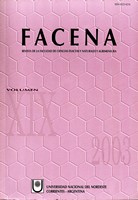Plasmatic electrolytes and weight modifications in wintering cows feeding with citrus by-products
DOI:
https://doi.org/10.30972/fac.1905508Palabras clave:
Wintering cows feeding, Citrus pulp supplementation, WeightResumen
To corroborate the effect of citrus by-product on liveweight evolution and plasmatic electrolytes, 80 wintering halfbred zebu cows maintained on native grassland, were used. Two consecutive years, 20 animals operated as controls (C) and others 20 were feeding (S) with fresh citrus pulp (15 ± 3 kg/animal, during 4 months). Periodic controls at 0, 30, 60, 90 and 120 days, were made. Results were statistically processed using a repeated measures design, with means comparison by orthogonal contrasts. Every year S registered higher levels of: magnesium (2.30 versus 2.20 and 2.05 versus 1.96 mg/dl), calcium (9.04 versus 8.35 and 8.36 versus 7.83 mg/dl), inorganic phosphorous (5.58 versus 5.04 and 4.98 versus 4.33 mg/dl), sodium (148.4 versus 144.4 and 147.0 versus 139.5 mEq/l), iron (143.3 versus 133.8 and 143.6 versus 142.0 µg/dl), and copper (118.1 versus 74.6 and 99.6 versus 59.6 µg/dl), as well as body weight gain ratio (492 versus 304 and 352 g/animal/day versus weight lost) than C. Treatment and time effects were significant (p < 0.05) in some cases. Differences between C and S began to be significant by the days 60-90 of the assay. The values of potassium fluctuated irregularly. Electrolyte improvement and quite good gain ratio endorse the use of this cheap by-product in cull cows feeding.








